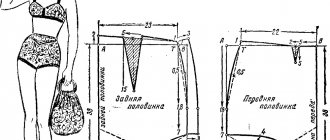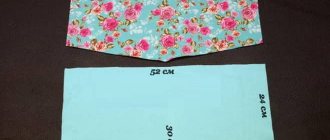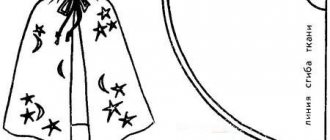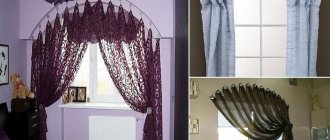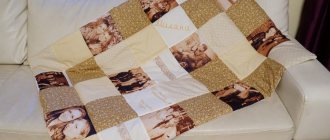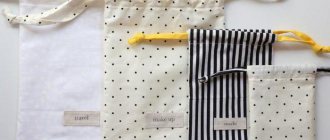What seam to sew curtains from two fabrics. Before you sew curtains yourself from two fabrics of different textures or colors, you need to decide on the model of the product. Curtains must fit into the interior of the room.
Curtains play an important role in the interior, so their purchase or tailoring needs to be carefully considered. Faceless products can ruin any room, making it uncomfortable. Curtains made from two multi-colored fabrics can bring coziness and update your kitchen, living room or bedroom. If previously it was believed that these products should be made exclusively from one fabric, today even the most conservative housewives prefer combined window curtains. When combining fabrics for sewing curtains, it is recommended to take into account certain rules.
Properties of different colors and their shades
When choosing fabric for window curtains consisting of 2 types of material, you should first study information about what properties different fabrics have when combined. Information about this is presented in the table:
| Colors | Impact on humans | Types of color combinations | The effect created by combining shades |
| White | Improves morale and gives a boost of energy | Monochrome (colors are in the same sector of the color wheel) | Creates a calm and elegant look |
| Yellow | Stimulates appetite, tones the nervous system, improves mood and thought processes | ||
| Blue | Calms | ||
| Blue | Calms, helps cope with insomnia | ||
| Violet | Reduces anxiety and promotes inspiration | ||
| Red | Excites and increases activity | Complementary (combination of two opposite shades) | Creates a visual dynamic effect |
| Orange | Improves mood, increases concentration | ||
| Brown | Instills confidence, gives a feeling of security and peace. May have a depressant effect. | ||
| Black | It can both depress and reduce tension and calm. | ||
| Green | Instills self-confidence, calms, balances | ||
| Grey | Disciplines, can oppress |
How to combine plain, colored and patterned fabrics correctly?
Combining two fabrics is primarily a matter of taste. However, there are certain rules that, if followed, will make this task easier. When combining monochromatic fabrics, you can give free rein to your imagination. If you want to decorate a room in soothing colors, it is better to use a monochrome approach, for example, choose canvases in rich green and light green shades. When choosing the color of the material, it is recommended not only to rely on personal preferences, but also to take into account the color scheme used in the interior of the room.
If you want to add a bright accent, you can combine materials according to complementary characteristics, for example, yellow and lilac. However, in any case, they should look harmonious together.
As for the combination of canvases with different patterns and patterns, today any combination is allowed, even the most daring and seemingly not entirely correct combination. So, fabric with large flowers can be combined with striped material. The main thing is that the same shades are present on the combined materials. In this case, the tulle can be the same color as the one on the canvas.
How to combine fabrics of different textures?
The most successful and harmonious look are curtains made from fabrics of the same or similar textures. This is due to the fact that, firstly, this approach allows you to increase the visual appeal of the product, and secondly, fabrics of different types can shrink differently after washing, as a result of which the curtains become deformed and will look untidy on the window.
If you intend to use materials that differ from each other in texture for sewing curtains, it is recommended to follow the following rules:
- Consider whether the window curtains' mounting structure will withstand a combination of heavy materials. To prevent the cornice from sagging, it is recommended to combine a thick fabric with a transparent one, for example, the one used for sewing tulle. Curtains made from two materials with a wicker structure of varying degrees of transparency look beautiful.
- To prevent combined curtains from different fabrics from looking disjointed on the windows, use some common element (braid, tieback, frill) when creating the design.
- Choose fabrics that are resistant to shrinkage.
- When sewing curtains for rooms in a restrained style, give preference to materials of the same color but different textures.
- Consider the degree of darkening the room requires. If kitchen curtains can be made from light translucent fabrics, then bedroom curtains should be made of dense fabrics that can reliably protect the room from the bright sun.
What to consider when combining curtains
The simplest, most affordable, but still original way to decorate a window opening is to combine fabrics of different shades and textures. When choosing a material for combined curtains, you will need to take into account their style, shade, texture and density. The functional purpose of the room is no less important. So, in a small living room or kitchen, choose fabrics that allow daytime color to pass through, but in the bedroom you need to be able to shade the room at any time of the day.
Blue curtains in the bedroom Source expert-byt.ru
Thus, colorful floral patterns, stripes, checks or polka dots are characteristic of the Provence style, but would be completely inappropriate in the loft style.
It is also worth considering the orientation of the room to the cardinal points. For “warm rooms” you can choose fabrics of neutral and “cool” shades; it is advisable to combine thin curtains with thicker material that can protect from sunlight. For northern rooms, on the contrary, rich warm shades are suitable.
Decorating a living room with a bay window Source runa-dekor.ru
In a classic style Source www.infostroyadvice.ru/
Ideas for different models of curtains made of two fabrics
It is recommended to choose a curtain model depending on the room in which you plan to hang them: in the kitchen, bedroom or living room. There are certain requirements for the style of curtains in the listed rooms. Only if they are followed will it be possible to most harmoniously fit window curtains into the interior. What should you consider when choosing a curtain model?
Cozy or formal living room
Curtains for the living room can be of any model. The main thing is that they fit harmoniously into the overall decor of the room. Just as when choosing the color of the curtains for this room, when choosing the style of the future product, you need to take into account the interior design that was used in its arrangement.
In a modern-style living room, straight curtains without tiebacks look most harmonious. In a hall with an interior designed in a classic direction, decorative elements such as tiebacks, lambrequins, and drapery will come in handy. Minimalism and modernism require clear, simple lines; curtains of complex shapes with abundant folds and puffs would look out of place here. Curtains with ties or hourglass designs will fit perfectly into the Provence style.
Kitchen: beautiful and functional
Kitchen curtains require more frequent washing than curtains hanging in other rooms. To make this task easier, when sewing these products, it is recommended to give preference to simple models without complex elements. Window curtains in the form of rectangles look most appropriate in a room intended for preparing and eating food.
Various decorative elements on curtains (tiebacks, ruffles) can make a room made in the Provence style and other similar styles more comfortable. Cafe curtains will also fit harmoniously into this interior. Quite often, when sewing kitchen curtains, they do without tulle. Most apartments in our country have small kitchens. To visually expand the space in this room, it is not recommended to use floor-length curtains. Long products, on the contrary, can increase the height of the ceilings.
Calm bedroom
Straight curtains with tie-backs or free-hanging ones will fit harmoniously into a bedroom designed in a restrained style. It is not recommended to overload a place intended for rest and sleep with unnecessary details. This recommendation also applies to curtains. Their main purpose is protection from the sun and delicately maintaining the overall style of the room.
When sewing curtains for the bedroom, you should use tulle. It allows diffused light to enter the room during the day when the curtains are pulled apart.
Children's: option for girls and boys
When planning to sew curtains for a children's room, you need to take into account the gender and age of the child living in it. Not only the color of the future product, but also its model depends on this. For boys of the middle and older age groups, window curtains of a discreet shape are suitable. Curtains for the bedroom for girls and young children can be scalloped, with ruffles, slouch, trains, etc.
Combined models for rooms
kitchen
Curtains in the kitchen in a combined style should help create coziness in a room full of functional devices and modern appliances. Their task is not to keep out light or noise, but to:
- inspire the hostess to culinary feats;
- contribute to the creation of a calm atmosphere during family dinners;
- get into a working mood in the morning.
The task is not easy, but it is the ability to combine different materials and color shades that creates the prerequisites for its successful solution.
living room
The living room is distinguished by its unique pomp and status. Therefore, color combinations for the curtains of this room should be chosen bright, contrasting and classic: coffee-chocolate, golden-turquoise, beige-peach, purple-lilac. The combined curtains of the living room are multi-layered and complex: with embroidered lambrequins, scallops and fringes.
bedroom
Curtains in the bedroom should create a peaceful environment that promotes sound sleep. Therefore, pastel colors and dense fabrics such as satin, jacquard, velvet or wool are used. Multi-layering in bedroom curtains is justified by the ability to protect against the penetration of light, prying eyes and muffle street sounds.
Corridor
Curtains in the hallway can serve as doors; in this case, it is better to choose heavy decorative fabric. You can make combined double-sided curtains that will look presentable from any side of the room. Curtains made of light materials will visually expand a narrow corridor, while combinations with vertical stripes will elongate a low corridor.
The arched space of the corridor will be decorated with short combined curtains - they will decorate the room and will not interfere with the passage.
Children's room
Curtains for a children's room, created in the form of a combination of different fabrics and colors, are an excellent solution, as they allow you to soothe bright colors with a neutral companion, and create interesting compositions from plain fabrics. The priority in a children's room is natural fabrics.
Details: fastening methods, sliding mechanisms, tiebacks and other decor
An important point when sewing combined window curtains is the method of fastening. It comes in the following types:
- directly to the fabric;
- on one cornice there are panels complementing each other;
- fastening additional elements on separate structures (cornice board, additional hooks, loops).
Often, when sewing combined curtains, roller blinds and classic products are combined. The convenience of this design lies in the fact that on a hot sunny day, a lowered roller curtain will protect you from scorching rays, and in the evening, tightly closed heavy curtains will create an atmosphere of warmth and comfort, and will also reliably protect you from prying eyes. Roller and Roman blind designs are convenient if window decoration does not involve moving curtains.
A simple model of two-color curtains: DIY sewing
Even a novice seamstress can combine two fabrics to sew curtains. It is better for inexperienced craftswomen to use fabrics of the same texture, as they are easier to sew. You can sew this product with your own hands according to the following scheme:
- Measure the length of the cornice and the distance from the hook to the floor. Each product requires an average of 1.5–2 lengths of fastening device. To determine the height of the curtain, you need to add the length of the fabric in the upper and lower parts to the height of the ceilings. When combining two canvases vertically, 2 cm is added to each side, and when placed horizontally, to the height of the product.
- Cut the material in half vertically.
- Place the pieces together with the right sides together and, stepping back 1 cm from the edge, sew with a simple seam.
- Press seams.
- Turning the sides of the future product 2 mm on each side, steam thoroughly. Repeat the procedure.
- Place a stitch at the fold. Sew the bottom edge in the same way.
- Having folded the product to the width of the existing tape, iron this area.
- Apply tape to the lapel and secure the pieces with pins.
- Place a line along the top and bottom edges of the tape. Do the same with the other part of the product.
What is meant by double curtains?
According to the name, this is a special way of decorating curtains, in which it is possible to combine 2 types of fabrics. Depending on the method of sewing and hanging, this group of products is divided into 3 types.
Double-layer - curtains made of 2 separately hanging panels that can be moved together or separately.
Double-sided - lined with fabric of a different color and texture.
Combined - combining 2 types of textiles in each panel.
When making any type of such curtains, you need to take into account that the fabrics of the upper and lower parts of the curtains must be combined. The choice of contrasting or shading colors depends on the overall color scheme of the room. It is desirable that one of the shades appears in the interior as an accent or is present in other details. This technique will help harmoniously fit the volumetric product into the overall style of the room.
In a classic interior, curtains made from plain layers of textiles will look most advantageous. It is also possible to use fabrics with ornaments. In this case, it is advisable to make only 1 layer of such material. If you want both panels to be patterned, then you should select curtains with the same pattern, but in different shades. In any other case, double curtains will look ridiculous. A thin transparent curtain (tulle, organza, veil) should be a neutral shade or match one of the layers of a thick double curtain.
Two-color curtains for the kitchen
For the kitchen, it is advisable to select short curtains so that they are slightly higher or lower than the window sill. In the kitchen, functionality and practicality are important, although beauty is also taken into account. Choose light fabrics; dense fabrics will not fit well into the interior of the kitchen, because it is important that there is a lot of sunlight.
This solution looks very interesting.
How to make double curtains yourself?
Depending on the option chosen from those presented above, sewing curtains from 2 layers of fabric will look different. But in any case, it is necessary to take measurements of the length and width of each panel in the lower and upper layers. Very often the second (outer) element is made solely for decorative purposes. Therefore, the top layer of textiles can be narrower and shorter than the main one, which will serve as a mobile working curtain.
Both canvases can be made functional. In this case, for one of them you should choose a more transparent fabric, using such a curtain in the hottest part of the day if the windows face south. A thicker curtain will serve as an evening accessory.
The simplest option is two-layer. To make such a curtain with your own hands you will need:
- ;
- fabrics of the desired shades;
- sewing machine.
Cut out 2 pieces for the bottom and top layers of the curtains. The cut is simple:
- To form beautiful folds, it is advisable to multiply the value of the width of 1 panel taken from the window by 1.2-1.5. This means that for every 1 m of width 20-50 cm will be added. The length measurement does not change.
- To the calculated measurements of the length and width of a separate panel, you need to add 2-3 cm for hemming each side edge and top and 5-6 cm for decorating the bottom cut.
Fold the cut rectangles and machine stitch them along the side and top edges. Leave the lower ones untreated.
Hang the curtains on a cornice with 3 guides: the first layer located near the window is tulle or other transparent fabric, the next 2 are a double curtain - all together this will be a three-layer curtain composition. Straightening each panel in turn, measure the desired distance from the floor to the bottom cut. Place marks on the fabric, fold and baste the bottom. Remove the panels and sew the hems on the machine. With this processing method, the bottom edge of the curtain will look very smooth and neat. Iron the finished double curtains and hang them on the window.
You can decorate a two-layer curtain in different ways: take the top curtain with tiebacks, tie it with a ribbon, leaving it hanging vertically, tie it with a loose knot if the top curtain is narrow and thin.
If the cornice has only 2 guides, one of which will have tulle, then the double layer can be hung on the outer rod, fixing the clips in turn on the lower and then on the upper canvas. They can only be moved together. If the top layer performs exclusively decorative functions and there is a cornice with a front strip, you can attach it with Velcro tape (Velcro). In this case, one part of it is glued to the bar, and the second must be sewn to the underside of the decorative layer of the curtain.
Self-tailoring
Among those who are accustomed to decorating the house on their own, designing and sewing curtains with their own hands is welcomed. If you have some sewing skills, this is quite affordable.
Advantages
Sewing curtains and curtains with your own hands has many advantages. This allows you to choose the ideal combination of colors and materials for the interior. Specialized fabric stores today offer a wide selection of different materials, among which you will definitely find the right option.
Self-tailoring will allow you to realize the most interesting ideas for sewing curtains - vertical and horizontal combinations of materials, combinations of plain and printed fabrics, curtains of two colors with a lambrequin. Thus, you can get an exclusive and beautiful interior and realize your creative abilities. In addition, this method will also save the family budget due to the absence of expenses for the work of a seamstress.
How to sew a curtain with a lining?
With this option of sewing the curtain, it will be double-sided. Decorative functions are performed not only by the top, but also by the bottom layer of fabric. Therefore, textiles for both the face and the lining should be chosen of good quality, combining parts by color in accordance with the rules given above.
The measurements for all parts will be the same: half the width of the window with casing, multiplied by a factor of 1.5. The length is calculated arbitrarily, from the location of the suspension to the desired height above the floor. To the length and width measurements you need to add 1.5-2 cm seam allowances for the bottom and side cuts (for each) and 5-15 cm for the top. Depending on whether there will be a scallop and what its height is, you need to choose the size of the upper allowance.
We will cut 4 identical rectangles (2 from front fabric and 2 from textile for lining). Each half of the curtain is sewn using the following technology:
- Place the lining and top pieces facing each other, aligning the bottom and side edges. Baste and machine stitch with a simple stitch. Pull the fabric lightly along the line.
- It is imperative to process all sections, regardless of the fact that they will be inside. Very often the fabric on the window is visible through, and the fibers sticking out inside will look sloppy.
- The edges of each seam must be ironed onto the front part of the curtain clearly along the stitch line.
- Turn the resulting “bag” onto your face, steam the seams, pulling them a little with your hand.
- To prevent the lining from pulling the front part together, when stitching the top edges, you need to make an allowance on the wrong side of the panel. To do this, lay the curtain with the lining facing up and carefully straighten it. Fold the edge 1-1.5 cm inward, releasing the lining layer by 1-2 mm. Sweep the product, hang the curtain, evaluate the appearance. If the seams are well ironed and the top is carefully processed, defects usually do not occur. Remove the curtain and place the top at a distance of 1-2 mm from the edge.
- Sew the curtain braid from the inside out (right along the edge, 5-7 mm below the edge or to form a scallop). Gather the panel and hang it on the cornice.
An option for decorating the top can be decorative loops made of fabric. In this case, the parts need to be prepared separately, each strip of fabric should be folded in half, and the free ends should be inserted between the layers of the curtain. Only after this will it be possible to sweep away the edges of the upper cut.
Straight panels will look very elegant and decorative if the lower corner of each is raised and secured at the level of the window sill on a hook attached to the wall near the window opening. You can also connect the 2 sides of the panel approximately in the middle of the height of the curtain, bending them over the face so that the beautiful lining becomes visible.
How to calculate fabric for curtains?
Calculations can only begin after the cornice has been installed. Then you will need to arm yourself with a metal construction tape measure and take the necessary measurements.
What needs to be taken into account when calculating the parameters of curtains made of two panels:
- desired length and width of the finished curtain;
- shrinkage allowance;
- presence of a pattern on the fabric.
Calculation of fabric length
First you need to decide how long the curtains are needed. There are several options:
- 1 cm above the window sill;
- 10-15 cm below the window sill;
- 1-2 cm above the floor;
- lie on the floor in a trail of 5-10 cm.
The length will also be affected by the types of fastening of the curtain to the curtain rod:
- Hooks, clothespins, clips. To hem the fabric at the top you need to leave an additional 2-3 cm.
- Eyelets are rings made of plastic, wood or metal. To calculate the length, you need to add 10-20 cm to the width of the lining tape.
- Loops or ribbon ties can be sewn to the top. Here it is enough to add a couple of centimeters on top to the hem of the fabric.
- For curtain tape, you will need to multiply its width by 2 and add 2-3 cm to the top edge.
- The drawstring requires adding its width to the length of the curtain. Usually it is 3-20 cm.
Thus, the length of the fabric is calculated taking into account the desired length of the finished product, the allowance for fastening to the cornice and for the hem at the bottom.
Calculation of material by width
Here, too, the main point remains the cornice. You need to take into account its length, and also leave 20-25 cm on each side, since these areas should remain open. The resulting value must be multiplied by the fabric assembly factor, which depends on the type of material:
- tulle, organza – 2-4;
- heavy matter – 1.5-2.
The larger the pattern, the fewer folds need to be formed, so the coefficient for fabric with a large print can be taken less.
And the last thing you need to add to the resulting value is the allowance for processing the seams on the sides. Usually there are two curtains on the window, so you need to add a couple of centimeters 4 times plus 2 cm for the seam in the middle of each curtain.
Shrinkage allowance
The more natural the fabric, the more it can shrink when washed. So, linen or cotton can decrease by 10%. To be on the safe side, add 5-8 cm in length. It is advisable to pre-wash the material before sewing. Sometimes for natural shrinkage it is enough to treat it with steam. After this, the fabric is dried and work begins.
Combined curtain
You can make a double curtain by combining different fabrics if you have a beautiful cut, which is too small to create a two-layer model or a lined version. Narrow strips of beautiful fabric, of course, cannot serve as curtains as such. They can be used as an excellent decorative element, which will look different when the curtains are closed or open, but always original and very successful.
For the main curtain in this case, it is better to take a plain, dense material. Determine the dimensions of the panel as usual: width depending on the size of the window with casing, multiplied by 1.5. The height is arbitrary. Allowances for finishing the edges: 2 cm for side cuts and top, 5-10 cm for hemming the bottom.
The sizes of decorative stripes will have to be selected based on the amount of textiles. Process the side cuts of all parts. The main, large canvas can be simply and elegantly combined with 1-2 stripes of a decorative layer as follows:
- Lay the main fabric on a flat surface and straighten it.
- If there will be a single decorative strip, it is better to sew it on the outer edge of the curtain (closer to the wall near the window opening). If there are 2 of them, then you can place them side by side closer to the outer edge or attach them to opposite sides of the panel. In any case, you will get an unusual decorative effect with different positions of the main curtain.
- To carefully sew combined curtains with your own hands, you need to lay the decorative strips in the selected place on top of the front side of the base, align the sides and baste the top edges to each other at a distance of 1-1.5 cm from the edge. Fold the edges to the wrong side of the base so that the seam is invisible from the face. Pin or iron the hem of the top.
- Turn it inside out. Baste the curtain braid at a distance of 0.5-1 cm from the fold line, machine stitch along the top and bottom edges. Hang the curtain on the rod.
Process the bottom of the main canvas and each decorative strip separately. To do this, you need to measure the height of the edge of the curtain from the floor, as indicated for a two-layer curtain.
You can sew curtains from 2 layers of fabric for the kitchen, bedroom or living room. It is advisable to approach the matter with all possible care. Only in this case the result will be magnificent.


